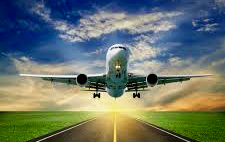VamoSkies: Pandemic Bounces, Labor Pains, Other A/L Turbulence.
Air Carriers & Craft + Labor Woes (Premise).
THE INCREDIBLE SHRINKING MODES.
A/A to SWA, GOODWILL BLUNTING.
10/25/21+—Whatever good terms and tidings took flight as pandemic travel restrictions loosened earlier this year were grounded this past holiday weekend as the world’s largest low-cost airline continued stranding thousands of passengers nationwide.
Over those past four days, Southwest Airlines cancelled over 2,300+ flights, delayed hundreds more, with no immediate relief in sight for travelers who have been lining up and camping out at airports coast to 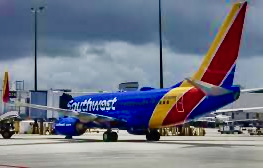 coast, desperately trying and paying dearly to change modes and plans—just like in the bad old pre-COVID days. The spiral of disruptions has cost (aggressively overreaching) SWA $75m in cancellations and exhausted its flight crews and staffs.
coast, desperately trying and paying dearly to change modes and plans—just like in the bad old pre-COVID days. The spiral of disruptions has cost (aggressively overreaching) SWA $75m in cancellations and exhausted its flight crews and staffs.
SWA attributes its latest schedule stripping (nearly 27% of its operational capacity) to foul weather and air traffic control problems plus pandemic-period staffing reductions—not least in Florida (hub to nearly 1/2 of its daily flights)—specifically citing a ‘hiccup’ at the Jacksonville Air Route Traffic Control Center. But the FAA counters that a few hours of military and staff training at the northern Florida facility caused no significant service disruption or air traffic control problems (e.g., affecting less than 2% of carrier operations for American and Spirit).
Instead the federal agency focus is on aircraft and flight crews being situated markedly out of place when the COVID travel slump ended with an unexpected explosion of pent-up summer demand. Southwest 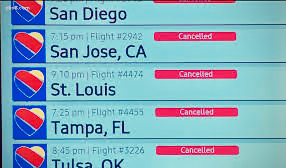 does concede that its fleet and staffing reductions throughout the pandemic via furloughs, buyouts and early retirement packages will make “…getting back to normal more difficult and prolonged,” said SWA Chairman/CEO Gary Kelly. But more schedule paring and capacity crunches may be in order to clear its operational skies, as most all airlines struggle to hire and/or rehire, retrain sufficient pilots and staff.
does concede that its fleet and staffing reductions throughout the pandemic via furloughs, buyouts and early retirement packages will make “…getting back to normal more difficult and prolonged,” said SWA Chairman/CEO Gary Kelly. But more schedule paring and capacity crunches may be in order to clear its operational skies, as most all airlines struggle to hire and/or rehire, retrain sufficient pilots and staff.
Jabs=Jobs?
Still, that doesn’t address the condor in the cockpit here, namely the Dallas-based airline’s recent mandate for companywide COVID vaccinations (or weekly testing) by December 8 (with certain exceptions)—no matter what anti-mandate executive orders come down from the Texas capital. Some headline-grabby politicos are already blaming the industrywide federal VAX directive for SWA’s current system breakdown, suggesting that a pilot walkout may be at work.
The Southwest Airlines Pilots Association (SWAPA) denies any such union stoppage as “false claims”, stating that its members are “…not participating in official or unofficial job actions”, rather ascribing the widespread cancellations/delays to poor company planning—as in overreaching route expansion during the summer travel rebound, scheduling more flights than they can operate. And to date, no other vaccine mandated carriers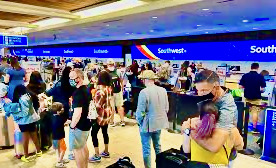 have so far reported commensurate crew and/or staffing shortfalls—although SWA is surely not the only airline to be facing such logistical meltdowns.
have so far reported commensurate crew and/or staffing shortfalls—although SWA is surely not the only airline to be facing such logistical meltdowns.
In any case, Southwest has already been weathering a quite difficult 2021, with the worst on-time performance and largest percentage of flight cancellations among the four major US airlines in June and July. At the same time its pilots, flight attendants (timing out of FAA allotted air hours) and mechanics—(let alone passengers)—have been complaining about the lofty budget airline’s downdraft and staffing cuts (some 7,000 fewer employees than in pre-pandemic times). Some assert that Southwest routing/operations have become “brittle and subject to massive failures under the slightest pressure”, what with out-of-position aircraft and tightly margined crews scattered, stranded to the winds.
An unsparing assessment to be sure, but given how bluntly the carrier is throttling the goodwill of its travel-hungry passengers, not exactly out of place thus far—absent some quick SWA qualitative pleasing and quantitative easing.
10/31/21—Southwest is not flying solo on this count, however, as the Utah-Based SkyWest regional airline had to cancel (463) and delay (900) more flights October 21-22 due to cascading “operational disfunction: i.e., its crews and aircraft were “out of position.” Now, et tu, American Airlines—cancelling nearly 2k flights over the Halloween weekend (12% of its operations), delaying nearly 30% of its entire capacity—citing, what else: foul weather (limited to 2 of 5 runways in windy DFW) and staffing shortages (of flight attendants and ground crews). Trick or mistreat? (MTC…)
Is Southwest Heading Southward?
PLAYING SOME SPIRITED JETBLUEs.
Update (3/7/23)—The US Justice Department has finally weight in pending JetBlue-Spirit Airlines marriage, filing an antitrust suit to throw wet rice on the entire $3.8bn affair—determining it to be ‘against the public interest’. Attorney General Merrick Garland concluded that a merger of two ‘budget’ rivals would result in reduced competition and increased prices, putting “… travel out of reach for many cost-conscious travelers.”
Scarcely helping the carriers’ case is that JetBlue’s aggressive, if not hostile attempt at creating the fifth largest US airline by 2024 (wishful thinking?), had already rankled federal regulators by forging a cozy 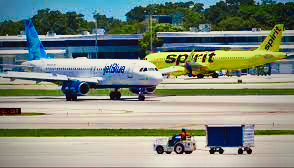 Northeast Alliance with American Airlines to more easily reserve/sell one another’s seats. Add in rumors that any newly merged JetBlue flights would offer fewer economy class seats (wow, that’s the Spirit!).
Northeast Alliance with American Airlines to more easily reserve/sell one another’s seats. Add in rumors that any newly merged JetBlue flights would offer fewer economy class seats (wow, that’s the Spirit!).
The proposed major airline merger, which would be the first in the US since Alaska’s takeover of Virgin America in 2016, aims at landing 10% of the domestic commercial market. JetBlue holds that it is truly a ‘bargain’ brand, lowering fares in whatever market it has entered, to more or less ‘disrupt’ the legacy carriers.
But DOJ counters that Spirit is really an ‘ultra low-cost’ airline, (albeit via higher fees), that frequently takes on the majors in their own markets nationwide. That JetBlue hews more toward Big Four domination, and the merger would seriously dull Spirit’s feisty competitive edge—not least along the East Coast, connecting down to the Caribbean.
New York, Massachusetts and District of Columbia have joined the Justice Department suit. So absent any negotiated resolution, brace to see them in court, and over the long haul, to be sure. (MTC…)
(10/20/22)–The final draw: All along, Spirit Airlines essentially played fellow discounter Frontier Group Holdings Inc. as a hole card to keep an already ‘blue-chipped’ JetBlue anteing up—no matter how the principals now spin it.
✈️ After months of bitter public haggling, four voting delays, Spirit investors trumped the carrier’s own board and handed its craven yellow jets over to JetBlue for a pot-busting $3.8bn cash. Once Frontier folded—standing pat and refusing to overbid beyond its $2.9bn cash-and-stock offer—JetBlue swooped back in, heaping planeloads of greenbacks on disSpirited stockholders to seal the deal.
The new, ostensibly conjoined carriers say their marriage, now fully shareholder approved, will be consummated by the second half of 2024, launching operations as the fifth-largest US airline (w/10% of the market) early in 2025. But that flight plan hangs on Justice Department regulatory approval of the merger, which is no pat hand given DOJ’s vigorous opposition to a current JetBlue-American Air Northeast Alliance (NEA) partnership, amid Biden administration antitrust concerns.
If, as Frontier has predicted, regulators nix the JetBlue-Spirit sale as being anti-competitive in an already over-concentrated airline industry, JetBlue will still owe Florida-based Spirit $70m and its shareholders a $400m ‘reverse breakup fee’. Either way, JetBlue will also be paying Spirit a monthly 10¢ per share ‘ticking fee’ from January 2023 until the deal fully closes.
Otherwise, both Spirit and JetBlue, lowly 6th and 10th respectively in recent D.O.T. on-time performance ratings, have announced they would continue to operate independently with customer loyalty ledgers unchanged until this high-flying merger is officially cleared to land.
Until then, we’ll hold tight, flush with questions, seeing a bluffer’s bet that may well crap out before it actually wheels down onto the tarmac. (MTC…)
(7/15/22)—At a time when Spirit Airlines suffers a fiery landing gear touchdown in Atlanta, this was not the only iffy/heated landing the Florida-based ultra lowfare carrier is executing these days.
✈️ The latest development: Four of a kind beats a wait? Nominal bidding frontrunner Frontier Group Holdings Inc. has requested a pause (to July 15) in Spirit Airlines shareholders’ vote (yet again) to give Frontier more time to sell its “last, best and final” proposal to more skeptical investors. Spirit’s board has obliged, extending the vote deadline until July 27, publicly continuing to prefer the Frontier scenario. It is essentially the fourth delay in this months-long merger saga, which finds rival JetBlue relentlessly sweetening it ante (now up to $3.7bn cash plus a per-month prepayment dividend), gradually wearing down the pro-Frontier Spirit boardroom crowd by the day.
Frontier holds fast to its bid ($2.7bn cash/stock), with a wild card of reverse termination fees should the US Justice Department ultimately nix the merger on grounds of anti-competition. Cushier low-cost  niche player JetBlue has upped its firm breakup fee to $400m, while Denver-based Frontier counters with a $350m fee. New York-based JetBlue maintains that its wing-and-prayer proposal offers a better chance of federal regulator approval, despite a DOJ suit to block JB’s partnering with American Airlines. Moreover, proxy-advisory firm International Shareholders Services (ISS) advises the Spirit board to accept the “clearly superior” JetBlue offer its has been rejecting for months now in favor of Frontier’s truer budget-to-budget carrier marriage and its likelier prospect of passing regulator scrutiny.
niche player JetBlue has upped its firm breakup fee to $400m, while Denver-based Frontier counters with a $350m fee. New York-based JetBlue maintains that its wing-and-prayer proposal offers a better chance of federal regulator approval, despite a DOJ suit to block JB’s partnering with American Airlines. Moreover, proxy-advisory firm International Shareholders Services (ISS) advises the Spirit board to accept the “clearly superior” JetBlue offer its has been rejecting for months now in favor of Frontier’s truer budget-to-budget carrier marriage and its likelier prospect of passing regulator scrutiny.
The Frontier CEO doesn’t exactly exude mountain man confidence by now, his carrier remaining “very far” from corralling enough Spirit shareholder voters to seal the deal. Yet committed Frontier stays (that’s the Spirit!), whereas JetBlue is “…ready to enter a binding agreement with Spirit as soon as practicable…immediately following Spirit shareholders voting against the Frontier (bid) on July 27.”
Pot’s Right?
The increasingly bitter bidding gamble has been poison to both JetBlue’s and Frontier’s stock prices, but the Spirit jackpot—and it unifying promise of instant 5th largest Big Air carrier status—appears to be a payoff too ski high to pass up or eventually fail. So, very public negotiations and advertising campaigns aside, two questions obtain after all these months:
Is JetBlue’s aggressive obsession with ultra lowfare Spirit Airlines coming out of strategic vision/ strength or fiscal, existential desperation? Conversely, will Frontier’s quieter, stand-pat strategy prove to be its last merger rodeo?
We travel consumers will soon discover whether a New York takeover artist or Colorado cowboy justice will at long last win this Spirited aerial showdown, and what it will mean to us. Nevertheless it is looking to be a bumpy, if not fiery landing either way. (MTC…)
(6/2/22)—Now look at what the Jet Stream Blue in: a $3.6bn counter offer for Spirit Airlines in a bid to expand its fleet and fly with the Big Four (namely American, United, Delta, Southwest= 66%+ of market).
✈️ Make that an all-cash lure (continuing to be rejected by Spirit Airlines, which cited thoroughly ‘unacceptable’ regulatory risk—leaning back toward Frontier’s offer as a better low-fare fit. JetBlue differs, so let another shareholder vs. seatholder battle begin):
Next step, JetBlue launches a hostile takeover ’tender offer’ directly to Spirit shareholders at $30 per share, $3.2bn total…nevertheless, Spirit’s board continues to urge rejection of JetBlue’s “risky…cynical” bid. But JetBlue keeps sweetening the pot, offering a higher ($3.4bn) deal, with an (anti-trust) breakup fee of $350m, prepaid as a shareholder dividend. Frontier stands pat (incl. a $250 breakup fee), and Spirit’s board members suggest they will play their hand later this month. Again, JetBlue’s aggressive bidding is meant to occlude the Frontier-Spirit merger plan announced in February☟—which was seen as forging a rival ultra-low-fare (U.L.C.C.) giant with compatible fleets of Pratt & Whitney-powered Airbus A320s. Affording cheap fares, albeit with minimal service and fees for select seating, checked bags and most everything else, that combined airline would supposedly comprise 10% of the domestic market and save passengers $1bn per year.
However JetBlue cites its “superior proposal”: a larger, more powerful challenge to the Bigs, grabbing some 8% of the US market while also bringing fares down. Such a “perfect match” with budget carrier Spirit would boost its fleet to 450 mainly Airbus planes—by retrofitting some Spirit aircraft—with 300+ more ordered over the next six years.
Primarily a domestic US carrier, New York-based JetBlue could gain system range, given Florida-Based 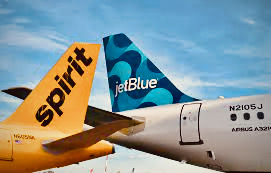 Spirit’s routes along the East Coast, legacy hubs west (Memphis to Dallas) and across the Caribbean and Latin America. This marriage would presumably establish a formidable ‘Fifth Major’ in market share (adding in JetBlue’s current coordinating ‘de facto merger’ arrangement with American Airlines), ostensibly offering low fares and “a greater travel experience.”
Spirit’s routes along the East Coast, legacy hubs west (Memphis to Dallas) and across the Caribbean and Latin America. This marriage would presumably establish a formidable ‘Fifth Major’ in market share (adding in JetBlue’s current coordinating ‘de facto merger’ arrangement with American Airlines), ostensibly offering low fares and “a greater travel experience.”
Not Surprisingly, Frontier (and its $2.9bn offer) argues that it and Spirit share more complementary bargain-fare, point-to-point business models in distinctly different regions. The Denver-based carrier paints JetBlue’s bid as creating East Coast overlap that would actually decrease competition, resulting in “more expensive travel”, since JetBlue is a decidedly higher-fare carrier known for its lie-flat beds seating, free Wi-Fi and full-serve meals, at least in premium business class.
Spirit itself has simply said the “unsolicited” JetBlue offer would be evaluated “…in the best interests of Spirit and its stockholders” within 10 business days—with of course little or no regard for us travelers. It also must be said that JetBlue is playing all sorts of hardball cards, not least filing ‘Vote No’ proxy statements to Spirit shareholders to reject the Frontier offer, while slinging mud at Frontier’s controlling management and Spirit’s board member ties with private equity outfit, Indigo Partners.
As to all that, Wall Street and most airline industry analysts quickly red-flagged the confounding, ‘out-of-the-Blue’ bid—skeptical that either merger would actually deliver as promised—none of the three carriers playing a particularly strong hand. For a time, JetBlue and Frontier shares were down some 8%, Spirit itself down over 3% before bouncing back. Clearly, these consolidation plays come amid a post-pandemic scramble for pilots, flight attendants and staffers as travel demand rapidly rebounds.
But whether the Department of Justice antitrust regulators climb aboard is another matter, since the Biden administration has already nixed the proposal for a more formal “Northeast Alliance” between American Airlines and…JetBlue.
Seems like more than ATC snags and congestion are affecting the overcrowded Florida skies these days. So will it be ‘pass the Spirits’, ‘thar she Blues’, or a rather expansive new Frontier? We still shall see…(MTC…)
☟CROSSING A DiSPIRITING FRONTIER?
(2/8/22)—If it’s not a flight, it’s a fleet. If it’s not a scheduling purge, it’s a carrier merge: Yet do two negatives make a positive?
Frontier and Spirit say positively, roger that, as the super low-cost airlines announce their plans to join forces, doubling down in a $6.6bn deal, essentially creating the nation’s fifth largest US carrier overnight. They would thereby be offering 1,000 daily flights to some 150 destinations in the US, Caribbean and Latin America. Even though their merger fanfare did face a rather inauspicious takeoff, with 130+ of Frontier’s flights and 25% of its operations being same-day grounded by a system-wide technical breakdown (said to be ‘quickly fixed’).
Nevertheless, Colorado-based Frontier is set to become the purchasing partner (51.5%), buying Spirit for $2.9bn in cash and 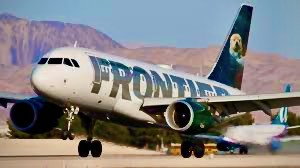 stock. It brings its Western states network to the marriage, while Florida-based Spirit provides broader Eastern US coverage and more international routes. Both carriers fly only Airbus A320 series jetliners, fleets expecting to grow from 280 (combined) to upwards of 500 by 2026.
stock. It brings its Western states network to the marriage, while Florida-based Spirit provides broader Eastern US coverage and more international routes. Both carriers fly only Airbus A320 series jetliners, fleets expecting to grow from 280 (combined) to upwards of 500 by 2026.
Targeted for a second-half 2022 close, this proposed fusion would vault ‘Frontier/Spirit’ past JetBlue and Alaska Air in terms of total miles flown by paying passengers, forging a giant budget carrier bested domestically only by the four biggies: American, Delta, Southwest and United—which control some 80% of the total airline market. It comes at a time when the three low-fare carriers (+ Allegiant) are rebounding more robustly from the pandemic downdraft (Q1 travel capacity per seat miles up 21-29% from 2019) than those lagging majors (down 16-18%). Because the leisure sector is surpassing business travel in passenger traffic lately—crammed coach seats faring better demand-wise than cushier first-class digs. Reason enough why their growth plans are soaring sky high.
No denying both airlines have suffered losses in the past two years. Spirit posted a $440.6m deficit in 2021 (federal assistance or no), after a far redder 2020 of $719.6m. Frontier lost 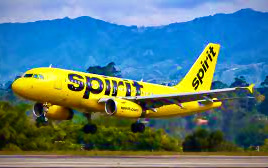 $299m in 2020 and 2021. Still, their respective CEOs claim their merger will yield an aggressive ultra low-fare competitor to the majors with more consumer-friendly fares, thereby “saving passengers some $1bn per year”) and affording better point-to-point service (e.g., to underserved smaller cities) in this booming leisure travel market. They say a combined Frontier/Spirit will also create 10,000 new jobs by 2026, with destinations and communities also benefitting—i.e., win, win all around.
$299m in 2020 and 2021. Still, their respective CEOs claim their merger will yield an aggressive ultra low-fare competitor to the majors with more consumer-friendly fares, thereby “saving passengers some $1bn per year”) and affording better point-to-point service (e.g., to underserved smaller cities) in this booming leisure travel market. They say a combined Frontier/Spirit will also create 10,000 new jobs by 2026, with destinations and communities also benefitting—i.e., win, win all around.
Then again, the two no-frills airlines bring dismal customer satisfaction ratings to the bargaining jetway. While both offer dirt-cheap base fares and minimal service, they routinely tack on extra fees for most everything else, not least carry-on bags. Spirit, which basically invented ‘ancillary revenue streams’, amassed the highest number of complaints (13.25 per 100,000 passengers) in Q1-3 2021, while Frontier rated 5.56 per, after a bruising 60.24 in 2020.
Little wonder merger critics fear a truer reality of this low-fare giant devouring smaller no-frills competitors—of fewer flights to fewer cities, with negligible service at higher fares and costs, particularly as passenger traffic increases come spring and summer.
Frontier Justice?
Ultimately the plan must first cross paths with a Biden administration that is prioritizing more competition in the airline industry. It notes this is the first such merger since Alaska Air swallowed up Virgin America in 2016, and such industry consolidation has resulted in the four major carriers shrinking from ten in the past 25 years. Which is perhaps why the feds aggressively blocked a recent American Air/JetBlue domestic ‘alliance’, and antitrust regulators will likely scrutinize the Frontier/Spirit merger plan all the more. This, despite the carriers’ assertion that a service overlap in merely 18% of their total routes limits the potential reduction of competition for passengers. And the combined airlines, currently ranked eighth/seventh respectively, will still only amount to 10% of the market overall.
At any rate, the Departments of Justice and Transportation will be the judges of that, as will the carriers’ respective pilot and flight attendant unions. And Vamigré will be crossing this new Frontier as well—if and when we should actually come to it. (MTC…)
SHRINK TO FITS.
(7/15/22)—Like cheap uni khakis on high spin dry, the shrinkage continues unabated, just as travel demand surges to fitful 2019 levels and beyond.
Most recently, and internationally: British Airways cut some 10,300 flights from its summer ’22 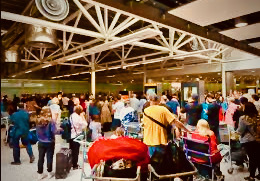 schedule due to capacity limitations: namely pilot and staffing (particularly tarmac/ramp workers) shortages. KLM Royal Dutch trims 2,000 scheduled flights, restricting ticket sales to acutely bottlenecked European destinations—Deutsche Lufthansa (2k cuts across the Continent), Air France and easyJet PLC following suit, with little public notice. Moreover, a pilots strike (1,000+) has so crippled debt ridden SAS AB that the leading Scandinavian carrier filed for Chapter 11 protection, under more favorable US conditions, for nine months to a year, cutting 50% of its scheduled flights per day.
schedule due to capacity limitations: namely pilot and staffing (particularly tarmac/ramp workers) shortages. KLM Royal Dutch trims 2,000 scheduled flights, restricting ticket sales to acutely bottlenecked European destinations—Deutsche Lufthansa (2k cuts across the Continent), Air France and easyJet PLC following suit, with little public notice. Moreover, a pilots strike (1,000+) has so crippled debt ridden SAS AB that the leading Scandinavian carrier filed for Chapter 11 protection, under more favorable US conditions, for nine months to a year, cutting 50% of its scheduled flights per day.
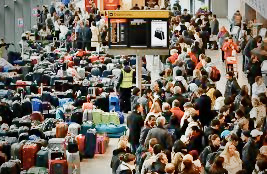 Seems at a time when inflation is hammering the euro, now on a 1:1 par with the US Dollar, travelers are attracted to relatively less expensive Continental destinations, even as historic heat and wildfires now rage across Europe. Yet more Euro flagships are unfurling by the day…to where London’s Heathrow airport is asking airlines to cap ticket sales (at 100k passengers per day) for the summer into September.
Seems at a time when inflation is hammering the euro, now on a 1:1 par with the US Dollar, travelers are attracted to relatively less expensive Continental destinations, even as historic heat and wildfires now rage across Europe. Yet more Euro flagships are unfurling by the day…to where London’s Heathrow airport is asking airlines to cap ticket sales (at 100k passengers per day) for the summer into September.
This despite stern rejections from carriers such as Emirates, which charges the airport management with incompetence (as in baggage backlogs—a colossal bag lag perhaps triggered by a June conveyor belt failure), underfunding and overall consumer disregard. While Amsterdam’s busy Schiphol Airport is little better off, having set its passenger limits on June 16. (MTC…)
BAKED ALASKA?
(6/8/22)—The first conspicuous stress cracks in air travel’s projected 2022 rebound are currently cleaving Alaska Airlines.
For the Seattle-based carrier continues to be hit, and hit hard, by a searing pilot ‘work stoppage’ that has resulted in well over 550 flight delays/cancellations since May 1 and counting, waylaying tens of thousands of passengers, with no contract 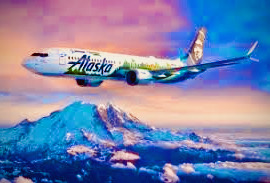 resolution on the horizon.
resolution on the horizon.
Over 3,100 Alaska Air pilots have forsaken their cockpits, some walking picket lines at Sea-Tac and other airports amid a nationwide commercial pilot shortage. The Airline Pilots Association union members have been locked in bitter contract negotiations with Alaska for three years, over issues of pay, job security and schedule stability. ALPA contends the carrier has not been bargaining seriously, and is attempting to blame pilots for its own mismanagement—not least its ‘half-baked’ systemwide preparation for a post-pandemic demand surge in air travel, which Alaska pilots say the company “should have seen coming all along.”
The carrier counters that a new pilot agreement is priority one, but “we must maintain growth and profitability for a strong future.” Claiming to have posted a meager $14m profit in Q4 2021 after $2.3bn in 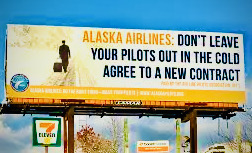 pandemic period losses, and now reporting a $143m Q1 loss (Wall Street projected $202m), Alaska Air still foresees improvement by June, even plans to boost its fleet by 100 planes to 400 overall, and hire 300 more pilots by year’s end.
pandemic period losses, and now reporting a $143m Q1 loss (Wall Street projected $202m), Alaska Air still foresees improvement by June, even plans to boost its fleet by 100 planes to 400 overall, and hire 300 more pilots by year’s end.
Where they expect to find them amid a pilot shortage lasting as long as seven years surely raises questions of competence and safety at the cockpit controls flying forward, as this isn’t simply a matter of crash courses or OJT. Moreover, more than 375 of the pilots Alaska has hired in recent months are from regional lines with experience solely on small jets or turboprops, while Alaska’s A320 or 737 training capacity is now limited.
Meantime, those contract negotiations are before a federal mediator, which have stalled to impasse thus far. So the carrier is offering a bonus 150% of pay for pilots willing to pickup extra flights—as it was short over 60 pilots in early April—admitting its ‘operational performance’ has been suffering, further impacted by harsh weather across the land. But ALPA warns its Alaska Air pilots are stressed and over stretched as it is, and that over 50 have been already been poached this year by other carriers promising better, easier working conditions.
This, while the airline’s customer service ranks are similarly thinned. Which means suddenly stalled or scrapped flights and up to ten-hour call center wait times, frustrated passengers being grounded, rerouted with last-minute flight-day notification or dished off to competing lines. So we travelers are taking the Alaska squabble and shortage in the shorts, if not contracting bouts of halting ‘terminalitis’, with more airline aggravation and inconvenience baked in by the day. And no amount of splashy “We Care” adverts seem to lighten that load.
Alas, Alaska Air may be the first major carrier stricken by pilot/crew and staffing shortages this spring, but quite likely won’t be the last: A distasteful vernal entrée, to be sure. (MTC…)![]()
MORE INCREDIBLE SHRINKING MODES.
(5/16/22)—The inevitable post-holiday hangover portends an increase in fretful, untoward layovers well through early 2022.
To be sure, travel demand is down into the new year thus far—what with COVID-Omicron, rough winter weather and the usual January lull. And even leading US airlines are smarting from millions upon millions of dollars in Q4 2021 losses, only Southwest and Alaska Air eking out modest profits.
So rather than soaring forward anew into ’22, most carriers are scaling back. Overall, domestic airline seat 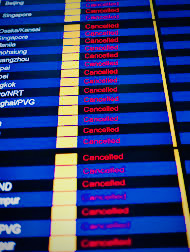 capacity is down some 12% over 2019, internationally off 52%. More specifically, Europe’s capacity is down over 42%—same for Asia, Africa and the Southwest Pacific—South America and the Caribbean upwards of 25%.
capacity is down some 12% over 2019, internationally off 52%. More specifically, Europe’s capacity is down over 42%—same for Asia, Africa and the Southwest Pacific—South America and the Caribbean upwards of 25%.
What these numbers add up to is significant fleet and schedule shrinkage, ‘proactive reductions’ in the parlance of one carrier, an industry wide trimming of seat sales. Take American Airlines (advisedly), which has cut thousands of flights through March, 1-6 runs per daily, out of six cities: New York, Miami, Chicago, Dallas, Phoenix and L.A. The Ft. Worth-based carrier cites, COVID/Omicron infections, winter storms, pilot shortages and fleet delivery delays, but insists it is not actually exiting the cities long term.
Chicago-based United is similarly paring its Q1 schedule, noting steeper labor and fuel costs (jet fuel up 122% of late) as well. Atlanta-based Delta is grounding hundreds of flights in February on, saying it continues to work together around the clock to reroute and substitute aircraft and crews.
JetBlue has cancelled nearly 1,300 flights through January, struggling to get crews back to work sooner, what with COVID cases and staff furloughs. The New York-based carrier is “proactively reducing” flights “with as much notice to customers as possible”—although some of its passengers report phone tree holds of up to five hours.
Even slightly Q4 profitable Southwest Air (Texas) and Seattle-based Alaska Airlines are cutting flight schedules between 10-15%. And these hairy capacity ‘hair cuts’ account for domestic air carriers alone. The only sliver of light on this horizon is the emergence of several scrappy low-fare start-ups, such as Breeze and PLAY Airlines, which seek a competitive edge via exclusively ‘differentiator’ apps and text communication. Alaska-based Northern Pacific, sister of Ravn regional line, plans to launch one-stop service between the US and northeast Asia (on 757s, with an Anchorage stopover) this summer. Meanwhile, Oslo-based Norse Atlantic Airways seeks 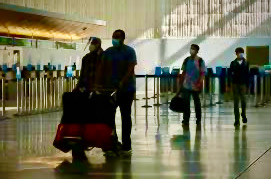 a foreign air carrier permit from the Department of Transportation to offer low-cost trans-Atlantic flights between California/Florida and Europe in coming months—routes recently ceded by Norwegian Air.
a foreign air carrier permit from the Department of Transportation to offer low-cost trans-Atlantic flights between California/Florida and Europe in coming months—routes recently ceded by Norwegian Air.
These newbies join Avelo Airlines, a Houston-based ultra low-cost carrier flying to a variety of heretofore ill-served domestic destinations out of Burbank, CA and New Haven, CT with a fleet of 737-700/800 aircraft.
Meantime, the majors’ widespread shrinkage leaves us travelers changing flights, itineraries, departure times, even hubs—if we are able to book a flights (particularly on non-stop routes) and board it at all. Moreover, as airlines adopt this less-is-more operational approach (e.g., easyJet is even stripping away available seat rows), we face the supply/demand conundrum of fewer choices at higher fares owing to arbitrarily limited flights, aircraft and crews.
The air travel squeeze is on, near term anyway. Reason enough why Vamigré will come to the lemon-aid in some potentially sour, if not fitful days ahead. (MTC…)
Airlines: Playing the Numbers.
10/27/21—For the major US airlines, it’s finally climb-back time, but not without government issue life vests.
Carriers by the numbers: Q3 earnings statements are in, with welcome summer high-season profits after months of mounting pandemic travel slump losses—albeit with a little help from their federal friends. American Airlines, for one, reported $169m in profits for the quarter, but without government aid, it would have lost $641m. Similarly, Southwest Air posted a third quarter gain of some $446m—minus government assistance, a loss of $135m.
For its part, Delta turned in a profit of $1.2bn for the quarter, but adjusted down to $194m without the federal aid –that line’s second quarterly gain in a row—Delta variant or no (however still 25% below 2019 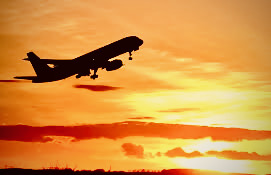 levels). Somewhat lagging was United, which largely avoided the unexpected summer demand surge that swamped overreaching carriers such as Spirit and SWA by somewhat tempering its scheduling and capacity re-growth until the travel market further stabilizes—slashing runs and saving cash reserves. Still, comparatively fewer flights (23% less than in summer 2019) to fewer destinations meant UAL lost $329m for the third quarter, once government aid was pared away.
levels). Somewhat lagging was United, which largely avoided the unexpected summer demand surge that swamped overreaching carriers such as Spirit and SWA by somewhat tempering its scheduling and capacity re-growth until the travel market further stabilizes—slashing runs and saving cash reserves. Still, comparatively fewer flights (23% less than in summer 2019) to fewer destinations meant UAL lost $329m for the third quarter, once government aid was pared away.
Industry executives cite flight delays, cancellations, route disruption and rising fuel costs—let alone continued pandemic pressures/restrictions as curbing the pace of carrier rebounds. Nevertheless, carriers are buoyed by projections of increased bookings once international travel bans are lifted, as well as strong holiday season demand. Underlying positive momentum is building for 2022, says Delta’s temporary CEO Ed Bastian; in fact, Alaska Airlines posted a profit of $194m even without the government aid.
So the airlines are cautiously recalibrating their schedules and adjusting capacity with the summer’s logistical crunch, price conscious customers and inflation clouds firmly in mind. Many are buying back stock and dividending holders—even ordering new, more fuel efficient aircraft, to where woeful Boeing now foresees moving its currently parked 4-5k jet backlog in due course, and delivering over 40k new planes over the next 20 years.
Nothing but blue skies, right? Ah, but there is still considerable clear-the-air turbulence to be negotiated dead ahead…
Pilots and Staffers in Rapid Dissent?
A recent full-page advertisement by the Master Executive Council (MEC) of the Airline Pilots Association (ALPA) spelled out the coming battle cry: “(Alaska) Airline’s Pilots Urge company CEO to do the right thing.” In other words, climb back time is also pay back time.
Not to belabor the point, but the same summer travel demand surge that caught the airlines off guard and 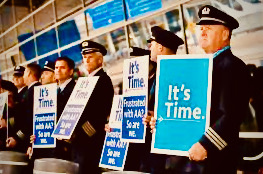 ill-prepared, also exhausted their flight crews and staffers. Early in the pandemic carriers trimmed their work forces through retirements, buyouts, furloughs and voluntary leaves to cut costs, thus overwhelming and overworking those fewer employees who remained come the summer rush.
ill-prepared, also exhausted their flight crews and staffers. Early in the pandemic carriers trimmed their work forces through retirements, buyouts, furloughs and voluntary leaves to cut costs, thus overwhelming and overworking those fewer employees who remained come the summer rush.
For months, flight crews have been stretch scheduled and rerouted; flight attendants diverted and harassed by unruly passengers, agents and mechanics overtime shifted to the breaking point—all according to their respective union representatives. Now the airlines are scrambling to recall laid-off employees and hire newcomers by the scores to cover staff shortages, even though that cheerful holiday demand scenario is not a slam dunk as of yet. United, for example, plans to hire upwards of 50 new pilots per week to gear up for Q4 and 2022—while other carriers race to fill over 8k new pilot slots on into 2022.
But not so fast, says union leaders, from ALPA to the Transport Workers, AFL-CIO. Reminding airlines of the essential, unstintingly sacrificial role their loyal members continue to play in the carriers’ pandemic slump survival and on the current rebound, the various unions are asking for well-earned recognition. They say that ‘guerdon’ should come in the form of quality-of-life improvements such as more flexible scheduling and job security, and other more favorable work rules. Involuntarily idled pilots and crews note their added burden of mandatory cockpit training and retraining before returning to active service.
Short of that, there are the rumors of dissident pilot walk/sick-outs and staffer work slowdowns, which the unions call “false claims”, instead blaming any productivity shortfalls on “poor (airline) operational planning.” Meantime come scattered rumblings of employee resistance to federal vaccination and mask mandates, flight crews on down.
Okay, maybe this isn’t exactly the high-profile drama of former Alitalia flight attendants undressing in  Rome’s Campidoglio to protest their job losses at the hands of Italy’s new national airline (ITA Airways). But the above issues are not quietly contrailing away anytime soon.
Rome’s Campidoglio to protest their job losses at the hands of Italy’s new national airline (ITA Airways). But the above issues are not quietly contrailing away anytime soon.
So what does this all mean to us travelers? Let’s just say when it comes to air travel surety and safety, pilot shortages, newbie onboard inexperience and myriad staffing tensions could be a matter of life and death in a number of months, if not years ahead.
Best to count on it—even as we partake of the bargain ‘flash fare’ sales (e.g., JetBlue’s $31 flights) that will likely be popping up between now and mid-December. (MMTC…)
Who’s Flying This Thing?
4/10/21—Filling empty cabins is one thing, filling empty cockpits quite another.
But that is precisely what airline executives face as more and more travelers seek a return to friendlier skies.
Little more than one year ago, the COVID-19 pandemic blitzed in and suddenly overruled those skies—and the global airline industry was going nowhere fast. So grounded carriers, contending with crushing travel restrictions and deserted airports, halted hiring, urged employees to take early retirement packages and/or voluntary leaves of absence. American Air, for example temporarily furloughed or cut hours on 1,600 pilots in 2020,  and only federal government aid stemmed thousands of other industry layoffs through early 2021. Even today’s passenger levels remain some 43% lower than in pre-pandemic days, not projected to recover to 2019 load factors until 2023.
and only federal government aid stemmed thousands of other industry layoffs through early 2021. Even today’s passenger levels remain some 43% lower than in pre-pandemic days, not projected to recover to 2019 load factors until 2023.
Yet rising they are, significantly beyond most industry expectations—whether due to coronavirus vaccination proliferation or simple (minded) anti-VAX resistance and pandemic fatigue. So airline executives now confront a flight demand surge and wave of mandatory pilot retirements that could serve to outstrip supply by as much as 13% in 2023. Indeed, nearly 50% of current US qualified pilots hit retirement age in that target year.
As a result United Airlines, for one, will soon hire some 300 pilots it had conditionally ‘waitlisted’ last year. 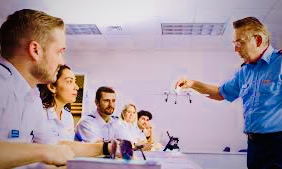 The carriers also seeks to train 5,000 new pilots, hiring 10,000 overall by 2030—50% of them women and people of color; other major and regional carriers are developing similar plans. United looks to fairly bolster its pilot roster through training at a Phoenix-based flight school it acquired in 2020. UAL intends to graduate an initial class of 20-100 from the one-year program. All will be equipped with commercial pilot licenses: first step in an up to five-year route from instructor to ‘puddle jumpers’ to regional, then major carrier cockpits.
The carriers also seeks to train 5,000 new pilots, hiring 10,000 overall by 2030—50% of them women and people of color; other major and regional carriers are developing similar plans. United looks to fairly bolster its pilot roster through training at a Phoenix-based flight school it acquired in 2020. UAL intends to graduate an initial class of 20-100 from the one-year program. All will be equipped with commercial pilot licenses: first step in an up to five-year route from instructor to ‘puddle jumpers’ to regional, then major carrier cockpits.
So Vamigré will be tracking such aviator progressions as airlines worldwide rush to re-stack their flight decks, seeing to it that their refills are up to the safety/performance standards and practices we travelers expect and deserve—in other words, without throwing us for a newbie loop…the loop. (MTC…)
Easy Does It.
Update: 12/5/20–Leave it to EasyJet to pull a ‘Wrong Way Corrigan’ in these pandemic times…
For while the airline industry struggles through a 737 MAX debacle and COVID-19 era collapse of travel demand, this low-cost carrier decides to pile on more trammels and fees. The latest big Easy money grab comes via the purchasing of added overhead storage bin lockers—sure to dissuade skittish flyers even further, many of whom already are calling it “an absolutely terrible move.” Other travelers even charge the British International airline with changing the conditions of tickets they had previously booked and purchased.
EasyJet claims the policy, set to begin next February 10, will expedite boarding and ‘increase punctuality’ by freeing up in-cabin overhead storage space. Until then, passengers can continue to board with a bag 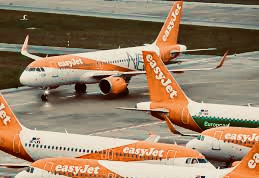 measuring no more than about 22 x 18 x 10 inches, which allows for the likes of small wheeled suitcases. But these new rules will require flyers wanting to locker additional hand luggage to buy costlier tickets (at premiums from $10.50 to upwards of $40 for longer flights). Travelers not locking in the more expensive fare will only be able to stuff a small carry-on bag beneath their seats, while checking larger luggage in the plane’s baggage hold at no extra charge.
measuring no more than about 22 x 18 x 10 inches, which allows for the likes of small wheeled suitcases. But these new rules will require flyers wanting to locker additional hand luggage to buy costlier tickets (at premiums from $10.50 to upwards of $40 for longer flights). Travelers not locking in the more expensive fare will only be able to stuff a small carry-on bag beneath their seats, while checking larger luggage in the plane’s baggage hold at no extra charge.
This, from a carrier that has long used a ‘passenger-friendly’ luggage allowance to distinguish itself from budget-fare competitors; one which is currently operating at barely 20% of capacity, with 2019 revenues lessened by half, and recently had its passenger records hacked. Little wonder some customers bemoan that EasyJet is “…monetizing every opportunity in a race to the bottom” with Ryanair, et al.
So maybe EJ had better take it easy on the pricey locker tack-ons—particularly in this challenging travel climate—lest we travelers ease on over to another line…![]()
So, depending on how we fly, air travel today can mean blue skies or black and blue skies. Now, down to brass acts, let’s get down (or up) to it, as the case may be…
Going high—that is, elite/premium first class? No problemo. Express security lines, ‘Trusted Traveler’ or CLEAR pre-check cards/scans, TSA’s Identigo program, bonus mile rewards, preferential dress codes, plush airport lounges; wide, cushy seats in spacious curtained fore-cabins—indeed, compartmentalized lie-flat bed consoles, with fine wines, gourmet cuisine, inflight digital media and connectivity no end: Nice trip, if you can book it. With a future full of sleek X-57 electric propulsion airliners. But, hey, that’s not the ticket for most of us…
To Wit: Foaming at the Snout.
![]() Latest on the airline/labor front comes news that an American Airlines mechanic has confessed to federal investigators that he superglued a patch of foam on a module of an A/A jetliner’s forward navigation system that measures speed, pitch and other data on a July flight bound from Miami to the Bahamas with 150 passengers aboard.
Latest on the airline/labor front comes news that an American Airlines mechanic has confessed to federal investigators that he superglued a patch of foam on a module of an A/A jetliner’s forward navigation system that measures speed, pitch and other data on a July flight bound from Miami to the Bahamas with 150 passengers aboard.
Fortunately, no one was injured in the resulting disruption—although passengers were delayed and diverted to another aircraft. Flight 2834’s had pilots noted an error message once they powered up the plane’s engines, returning to the gate, where another mechanic’s  inspection found the blockage of a tube leading from the plane’s exterior nose to its air data module beneath the cockpit.
inspection found the blockage of a tube leading from the plane’s exterior nose to its air data module beneath the cockpit.
Now, why would a glorified ramp rat who had worked for American since 1988 do something so diabolically bizarre? A Mister Abdul-Majeed Marouf Ahmed Alani was said to claim he was no terrorist, but simply an American Air employee fed up with bitter union contract negotiations that have dragged on since 2015.
His foaming rationale? Not to endanger 2834’s passengers, rather to cause a delayed or cancelled flight that would garner him some overtime pay at a time that the labor impasse had hit him financially. His sabotage caper was captured on video footage; fellow mechanics helped identify him.
Contract Milling About.
The festering labor negotiations have American suing its mechanics unions of fomenting a repair/maintenance slowdown, and, ironically, a refusal of overtime hours—an action that has resulted in over 1,200 flight delays and cancellations. A federal judge has recently agreed with the Fort Worth, Texas-based carrier, issuing a permanent injunction against the mechanics’ work slowdown and/or stoppage: Just more airline game playing with our lives.
As for Alani, he was suspended by American, then arrested and charged with “willfully damaging, destroying or disabling an aircraft” by the U.S. Attorney’s Office in the Southern District of Florida. Beyond that, he is currently being investigated for ISIS/terrorist ties.
But whatever the outcome of this latest airline-labor imbroglio, we again are reminded of who suffers these grubbing fools the most, don’t we. Accordingly, Vamigré will be toeing the picket lines, foaming at our consumer mouths at any more such laborious skullduggery. (MTC…)
![]()
Airborne Ups and Downs: the Wow! Factor.☟
For at a time when rock solid economic/ Vamonomic factors fuel record numbers of short and long-range roaming, air travel persists in serving up speed bumps.
Even online reservations and paperless ticketing only get us so far: That is, to airport terminals and the obstacle courses of DHS and TSA security lines.
Instead, we get to fly lower on the comfort chain. While swifter, smoother procedures increasing ease of movement (such as expanded Pre-Check and Global Entry) get bogged down in implementation or bureaucratic inertia.
Literally redressing after TSA metal detection or full-body scans in arresting positions, often rude rubber gloved patdowns with groinal groans, then X-rays of carry-on bags and relieved of meds, liquids/gels, bottles—anything remotely weaponizable—we brace for the airlines’ chaotically inconsistent boarding processes.
Namely, being sifted into priority zones according to A/L rewards status, gate agent shmoozing or basic fare paid. This determines whether we are boarded back-to-front in uncertain order, with no pretense of false equalogy, en masse cattle-call style or last-stand aft-cabin steerage, after the rush—even resulting in the triggering of pepper spray on a recent Hawaii-bound flight.
Flights are packed, likely due to airline fleet and schedule trimming, so our battle is on for scarce, skimpy carry-on space in overhead bins. Then we shoehorn into an incredibly shrinking economy seat, middle row, still coffee (or worse) damp, at that. We scrunch up and munch a bag of stale nuts, breathing foul ‘bleed cabin’ air, chins resting on our kneecaps as the seat ahead reclines. Row mates to either side snore away with sharp elbows or bodily disfunction, earphones blasting death metal or gangsta rap.
Padded on-time rankings, take-off delayed, arrival way beyond ETA, we scramble half-starved for baggage carousels, dreading the specter of mis-routed, fee-laden luggage. That connecting flight? Fugeddaboutit, and curl up in a fetal ball on the cold terminal floor, awaiting the next available flight, fretting over clearing customs and border protection at the other end.
And that’s if we’re lucky…
Nose Dive to the Bottom Line.
Cramped cabins and other downsides to today’s commercial flying experience are in response to customer behavior. So claim airline executives, who maintain that upwards of 70% of air travelers choose carriers and flights mainly on price—many opting for stripped down Basic Economy.
Thus unable to compete on product and quality of experience, airlines argue they must turn to serving their 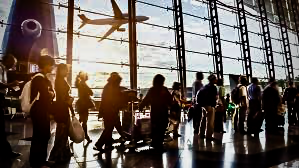 shareholders. This nod to income, margins, return on capital and stock market gain results in densification: Squeezing more passengers into fewer flights, padding lower fares with ancillary revenue (fees) of every type—i.e., serving up the most basic product for the lowest workable price.
shareholders. This nod to income, margins, return on capital and stock market gain results in densification: Squeezing more passengers into fewer flights, padding lower fares with ancillary revenue (fees) of every type—i.e., serving up the most basic product for the lowest workable price.
This, combined with comparatively lower fuel prices, has translated to soaring earnings (or up-sell revenue), delivering sky-high operating profit margins to stockholder accounts and airline executive bonus envelopes. As for most travelers, ‘it’s just about getting from A to B cheaply, so get used to it, unzip it and cattle up.’ Nevertheless, with the current run-up of crude oil PPB, and inevitable rise in jet fuel costs, airlines are already poised to bump up ticket prices and/or cut capacity—likely come the fall.
So where does that leave us Vamigrés?
Carriers’ Kiss of Dearth.
In the face of such surly airline lip service, we travelers are admonished to knuckle under, buckle down—no conflicts, no problems. Listen obediently to flight crews, stay transfixed in our shrinking seats in a pap screen, junk food coma. And mind our deferential manners, button our plaintive, quivering lips, for who knows, where lurk Federal air marshals and the like, incognito among us.
Rationale being, idle, cross-aisle threats are uber verboten—pre/post/inflight safety and security trump all—for onboard turbulence is our fault, after all.
Besides, flying has never been that much fun anyway. The good ol’ Golden Age never really was, airline insiders claim: With its higher relative fares, fewer choices, slower and shakier flights that negated better legroom and gratis amenities.
Nevertheless, today we increasingly file airline passenger complaints with the D.O.T. year over year, on matters of overbooking, bumping, flight delays, cancellations and fare/fee abuses. Congress hears the passenger frustration as well—horror stories of travelers being treated more like burdensome cargo than valued customers, even turning on one another under the pressures of cramped cabin conditions (as in RyanAir’s racist passenger rant).
The previous administration’s D.O.T. head set stronger regulations on fare transparency, rolling fees, baggage losses, flight delay fudging and tarmac wait times, along with D.O.T. reporting of them. Various attempts have been otherwise made at establishing a Passenger Bill of Rights for the flying public, on issues from flight cancellations to delay/lost bag compensation. As well as court resolution of disputes over contracts of carriage, such as carry-on bans, bumping up reciprocity rules and voucher valuations.
Airlines Fly High, But Into Headwinds?
Conversely, for the carriers, current skies are seemingly clear, no limit on fiscal visibility (global demand and economic conditions). Thanks to fleet, yield management scheduling, fortress hubs, customer segmentation and ever-expanding revenue streams (w/fee-based surcharges), the near-oligopolistic U.S. airline sector’s robust unit revenue growth has its stocks soaring its post-slump highs.
So come the industry mergers and acquisitions (e.g., Alaska-Virgin America), revitalized legacy carriers even looking overseas (American Air and China Southern, Delta and China Eastern) for further growth. Meanwhile, struggling state-flag airlines such as Alitalia and Turkish are prime targets for partnership. Also in the expansion market are Middle East 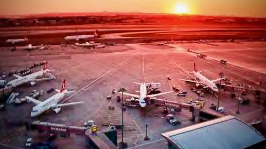 luxury lines like Qatar and Emirates, despite their particular terror and kidnapping/ransom concerns.
luxury lines like Qatar and Emirates, despite their particular terror and kidnapping/ransom concerns.
Curiously, Emirates Airline has recently partnered with budget carrier, Flydubai. Why so? Because low-fare, no-frills competitors are now dogfighting the legacy airlines worldwide; Indeed, catching a budget-minded traveler tailwind, slowly putting downward pressure on basic ticket prices, if not the fees tacked on—with higher fees yet, come fall, 2018. They are fundamentally coursing the jet stream originally plotted by Sir Freddie Laker and World Airways way back in 1978 Deregulation days. *
Southwest Air is a comparative graybeard pioneer within this space by now, JetBlue not far behind. Hot on their contrails are the narrow-bodied A320 and beleaguered 737-MAX 8 fleets of long-haulers Norwegian, Jetstar, Scoot, Azul, Cebu Pacific and AirAsiaX—to name a few—with roomier Bombardier C aircraft not far behind. While inefficient, behemoth Airbus A-380s and Boeing 747s bite the Arizona mothball dust.
![]() Meanwhile, air carriers currently face rising costs (fuel and non-fuel) and lower profit margins (down from $35.5b forecast to $28b in 2019) amid fitful global trade tensions. In addition, financial woes from the notorious 737 MAX groundings are compounded by a shortage of comparable, substitute aircraft and higher regulatory hurdles, not to mention Boeing’s costly delivery delays of its new 777X high efficiency, long-haul ‘super model’—prompted by problems with its GE9X turbine engine and carbon-composite wings.
Meanwhile, air carriers currently face rising costs (fuel and non-fuel) and lower profit margins (down from $35.5b forecast to $28b in 2019) amid fitful global trade tensions. In addition, financial woes from the notorious 737 MAX groundings are compounded by a shortage of comparable, substitute aircraft and higher regulatory hurdles, not to mention Boeing’s costly delivery delays of its new 777X high efficiency, long-haul ‘super model’—prompted by problems with its GE9X turbine engine and carbon-composite wings.
Soaring Competition.
Beyond schedule and operational inconveniences related to the 737 MAX fiasco, carriers face competition over increasingly scarce airport landing slots (especially in Europe)—product of surging growth and congestion in air travel worldwide—which is predicted to double up over the next decade and a half. Over 200 major airports around the globe are already running at full capacity, with minimal expansion (terminal or runway) in the offing, save for China, that is.
The current upshot: International Air Transport Association (IATA) authorizes airports to tighten up on the Worldwide Site Guidance System, via new ‘use-it-or-lose-it’ rules on 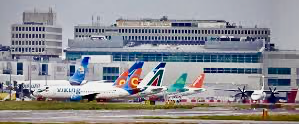 landing slot allocation. Thus adios, cozy airport and carrier buy-and-sell access to the precious gates, right when they are in overheated demand, triggered not least by the crush of budget on up to business airline startups. One case in point there: JetBlue’s brash occluding of dowdy, data-hacked British Airways on busy trans-Atlantic routes.
landing slot allocation. Thus adios, cozy airport and carrier buy-and-sell access to the precious gates, right when they are in overheated demand, triggered not least by the crush of budget on up to business airline startups. One case in point there: JetBlue’s brash occluding of dowdy, data-hacked British Airways on busy trans-Atlantic routes.
Add to that the terminal and scheduling havoc raised by the shorthanded (and high turnover) drag on TSA checkpoints due to low pay and high stress screener conditions—retention bonuses or no. Let alone the prevailing shortage of air traffic controllers and maintenance crews.
![]() Further on the airline labor front, American is currently tussling with its mechanics union over purported work slowdowns that have been causing a gust of flight delays and cancellations (some 30-80 per day through June ’19) . The carrier also claims its mechanics are nixing overtime and trips to various other airports to service idled/grounded airplanes. American alleges its mechanics union has carved out the busy summer season for action, when airlines are pressed the hardest.
Further on the airline labor front, American is currently tussling with its mechanics union over purported work slowdowns that have been causing a gust of flight delays and cancellations (some 30-80 per day through June ’19) . The carrier also claims its mechanics are nixing overtime and trips to various other airports to service idled/grounded airplanes. American alleges its mechanics union has carved out the busy summer season for action, when airlines are pressed the hardest.
A federal judge even issued a mid-June temporary restraining order barring the union from provoking and approving any job actions against American’s operations. But the Transport Workers Union/International Association of Machinists responds that it hasn’t authorized nor stoked a slowdown. It casts blame on the carrier’s own operational issues, as well as unseasonably stormy weather.
In any case, American just continues to cancel more flights by the day. As usual, we travelers get the shaft for disruption and unreliability, too often suffering terminal downtime and missed connections, not to mention paying substantial financial penalties. To wit, if a carrier blames bad weather for flight snafus, they routinely don’t cover rebooking, or voucher for lodging and meals.
The federal courts are now threatening A/A mechanics with fines and other sanctions if they are found to be weaponizing their labor to gain the advantage in contract negotiations. The union replies it is advising its members to adhere to normal work schedules and practices.
So Vamigré will continue to monitor whether or not the mechanics are throwing a wrench into peak summer airline operations, much less if any such stoppages/ actions spread to other carriers. Meantime, best to build in some extra terminal time this summer, and prepare to be disconnected or downright grounded in place. (MTC on this…)
+ Is Southwest Heading Southward?
More troubling and pressing yet is the paucity of qualified airline pilots. This, to where carriers such as American and JetBlue are establishing “ad initio” training programs, scrambling for prospects, teaching promising candidates from the ground up—classroom to simulator to actual cockpits. They and other airlines scurry to meet a need borne of rapidly expanding service and fleets, with a broader range of trainees through increased student financing and financial aid.
So who in fact is steering the ship, from where have they gained their wings and for how long have they commanded first or second seat? Really, what’s going down behind closed cockpit doors anymore? We shall see, alright, Vamigré will see about that too…
WOW! That Was Fast. ☟
![]() Moreover, in a shorter haul ‘war of attrition’ are Euro leader, Ryan Air, EasyJet, BA’s Level, or Lufthansa’s Eurowings. Add in WizzAir, GoAir, SpiceJet, Lion Air, VietJet—and Western Hemi’s WestJet, Canada’s Rouge, GOL/Brazil or U.S. carriers, Allegiant, and thriving Frontier and Spirit (the latter is even trying to improve its service and punctuality).
Moreover, in a shorter haul ‘war of attrition’ are Euro leader, Ryan Air, EasyJet, BA’s Level, or Lufthansa’s Eurowings. Add in WizzAir, GoAir, SpiceJet, Lion Air, VietJet—and Western Hemi’s WestJet, Canada’s Rouge, GOL/Brazil or U.S. carriers, Allegiant, and thriving Frontier and Spirit (the latter is even trying to improve its service and punctuality).
These are gradually eating into the U.S. Big Four’s Five-Star lunch—forcing the likes of United to begin 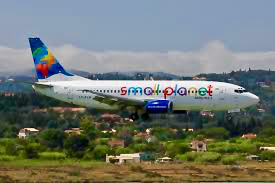 ever-so-slightly shaving fares and nudging up capacity. Meanwhile, Norwegian Air strains to challenge RyanAir’s service—the short and long of it, while Ryan cancels thousands of flights, strands hundreds of thousands of passengers due to labor disputes and staff scheduling snafus—suffering a serious profit drop. While Denmark’s bankrupt Primera Air folds without notice, cancelling all flights, stranding customers from Manchester to Newark to Malaga. + See: Cooking the Bookings.
ever-so-slightly shaving fares and nudging up capacity. Meanwhile, Norwegian Air strains to challenge RyanAir’s service—the short and long of it, while Ryan cancels thousands of flights, strands hundreds of thousands of passengers due to labor disputes and staff scheduling snafus—suffering a serious profit drop. While Denmark’s bankrupt Primera Air folds without notice, cancelling all flights, stranding customers from Manchester to Newark to Malaga. + See: Cooking the Bookings.
The latest to bail out of the skies is WOW! Air, a trans-Atlantic low-fare airline based in Iceland that launched in 2011, flying Airbus A320s single aisles and A33o widebodies from U.S. cities to Europe. Its demise follows a cortége of failed budget carriers, count ’em: Monarch and Air Berlin in 2017; Asurair Germany, Cobalt Air, Small 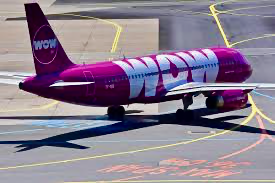 Planet Airlines and Skywork last year; Germania, Jet, Flybe and Flybmi in 2019 thus far.
Planet Airlines and Skywork last year; Germania, Jet, Flybe and Flybmi in 2019 thus far.
Causes in common? Rising fuel prices, narrow profit margins (if any), carbon costs—but mostly the cutthroat competition among low cap, low-frills startups in an overcrowded long-haul market. In WOW’s case, the hemorrhaging carrier had been pursuing a sale for months, primarily with Icelandic Air. But the flagship line begged off, as did WOW! bondholders to further issuances.
So WOW! folded with merely a sudden travel alert, stranding 2,700 to 4000 passengers, many in its Reykjavik, Iceland hub. Yet it wasn’t that the carrier tanked, but how WOW! went about it—such a maddeningly familiar scenario. More precisely, how all these budget, fee-falling upstarts go about their failing business.
For example, WOW! Air continued selling tickets until the very moment it ceased operations. The carrier’s abrupt ‘Travel Alert’, which prompted passenger strandings from the U.S. heartland to the heart of Europe—after hours of flight delays and cancellations.
And that doesn’t even to begin to account for the resulting plunge in Iceland’s travel/tourism-charged economy, which had grown to 10% of the North Atlantic island’s GDP since its financial meltdown of 2008. With WOW!’s folding, a foreign visitor rate that had topped 2m in 2017, has suddenly dropped nearly 20%, as in fewer and fewer ‘free spending’ Americans. Particularly hard hit have been the air hub’s Husavik whale/seal watching, Húsafell’s lava caves and the island’s numerous glaciers, hot springs and waterfalls—not to mention all the ‘Game of Thrones’ selfie mania.
WOWza! Pizza By the Pan…
WOW’s (far too typical) aid and advice, after doling out compensatory pizza slices right before the pan…demonium, was 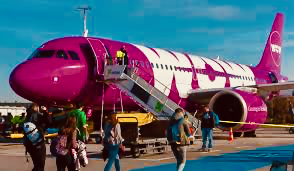 for it stiffed customers to contact their own credit card companies or travel agents for refunds. And should you carry travel insurance, awesome! Except for the fact that less than half of such policies cover airline failures, and many are a black hole of exemptions and exceptions—beware the creeping codicils. (MTC…)
for it stiffed customers to contact their own credit card companies or travel agents for refunds. And should you carry travel insurance, awesome! Except for the fact that less than half of such policies cover airline failures, and many are a black hole of exemptions and exceptions—beware the creeping codicils. (MTC…)
But can’t wait? Try for ‘rescue fares’ from other carriers, for the next several days anyway—say, from Icelandic Air, EasyJet or Hungary’s WIZZ. Really, folks, Norwegian Air might offer a 25% discount. Although of course these repatriation fares are subject to availability, and don’t forget your valid WOW! Air booking.
Or let the boarding gate hit you in the ass on your way back to the cab line. In other words, time to play Rushin’ Roulette, thank you very much for your patience and loyal patronage.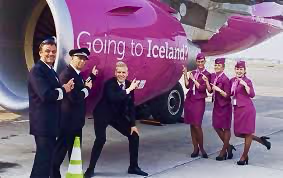
It’s a familiar passenger runaround, triggered by way too many no-frills start-up airlines out there, flying on a wing and a rock-bottom sales pitch.
Therefore air carriers all, be on notice: We Vamigrés intend to fly, ply, pry, plot and pit you against one another (yes, perhaps even including customizable cabins and general aviation ride-sharing) if we have to, as a means of gaining leverage and consumer advantage amid the specter of rising COT (cost of travel) and syndromic airline abuses, ever in the service of:
The finest quality, most uniquely memorable travel experience for time, energy and money expended. Or just call it VamoSutra…
While current T/T media provide pitifully timid, compromised pushback. Together, we can do much better…
___________________________________________________________________
* Per current International Airline Travel Association (IATA) data:
⁃ Low-fare total seats hover between 35-50%
⁃ Average round-trip fares have dropped by 50% since 1995
⁃ AZUL-JetBlue: 17.5% Brazil market share (20.6M passengers)
⁃ In Asia, service with more direct city-to-city flight choices than ever
⁃ In U.S.: one in three flies on a budget carrier (India, Asia=50%+)
⁃ In U.S.: nearly 40% of market share for budget lines; ultra discounters upwards of 10%
⁃ Ryan Air, now is the largest Euro airline; EasyJet larger than British Airways
⁃ Hungary’s WizzAir is substantially beating flag carrier, MALEV Hungarian Air
⁃ As budgets/discounters burgeon and bludgeon their way into global travel overall…
Air Carriers & Craft (BA’s IT BS)
VamoSpace/Aircraft: Supersonic Transport.2–Boom or Bust?

